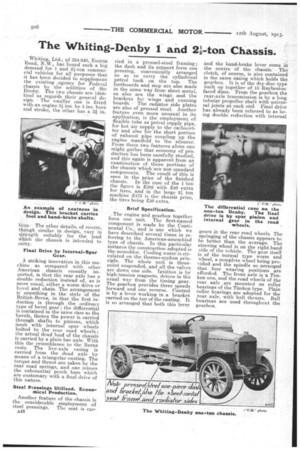The Whiting-Denby 1 and 21-ton Chassis.
Page 18

If you've noticed an error in this article please click here to report it so we can fix it.
Whiting, Ltd., ef 334-340, Euston Road, N. W., has found such a big demand for 1 and 2i-ton commercial vehicles for all purposes that it has been decided to supplement the existing Agency for Federal chassis by the addition of the Denby. The two chassis are iden-tieal as regards their geneeal design. The smaller one is fitted with an engine 312 ins. by 5 ins, bore and stroke, the other has a 3i in.
bore. The other details, of course, tho.iigh similar in design, vary in s,firength suitably for the load iitich the chassis is intended to carry.
Final Drive by Internal-Spur A striking innovation in this machine as compared with other American dhassis recently imperted, is that the rear axle has a double reduction instead of, as is more usual, either a worm drive or bevel and chain. The arrangement is something in the style of the British-Berna, in that the first reduction is through the ordinary type of bevel gear ; the differential is contained in the same ease as the bevels, thence the power is carried through shafts to pinions, which Mesh with internal spur wheels bolted to the rear road wheels ; the actual dead load of the chassis is carried by a plain bar axle. With this the resemblance to the Berna rests. The live-axle easing is carried from the dead axle by means of a triangular casting. The torque and thrust are taken by the rear road springs, and one misses the substantial perch bars which are customary with a final drive of this nature.
Steel Pressings Utilized. Economical Production.
Another feature of the chassis is the considerable employment, of
steel pressings. The seat is carA48 ried in a pressed-steel framing ; the dash and its support form one pressing, conveniently arranged so as to carry the cylindrical petrol tank on the top. • The footboards and step are also made in the same way from sheet metal, as also are the wings and the brackets for wings • and running boarda. • The radiator side plates are also of pressed steel. Another feature even more unusual in its application, is the employment of flexible tube as petrol supply pipe, for hot air supply to the carburetter and also for the short portion of exhaust pipe coupling up the engine manifold to the silencer. From these two features alone one might gather that economy of production has been carefully studied, and this again is apparent from an examination of those portions of thechassis which are-notstandard components. The result of this is seen in the price of the finished chassis. In the case of the 1 ton the figure is £385 with £40 extra for tires, and in the large 21 ton machine 475 is the chassis price, the tires being £50 extra.
Brief Specification.
The engine and gearbox together form one unit. The first-named component is made lay the Continental Co., and is one which we have described several times in referring to the American-assembled type of chassis. In this particular instance the construction adopted is the monobloc. cooling water is circulated on the thermo-syphon principle. The whole unit is threepoint suspended, and all the valves are down one side. Ignition is by high-tension magneto, driven in the usual way from the timing gear. The gearbox provides three speeds forward and one reverse. Control is by a lever working in a bracket carried on the ton of the casting. It is so arranged that both this lever and the hand-brake lever come in the centre of the chassis. . The clutch, of course, is also contained in the same casing which holds the gearbox. It is of the dry-disc type built up together. of 15 Ra,yhestosr faced discs. From the gearbox the rear-axle transmission is by a long tubular propeller shaft with universal joints at each ehd. Final drive has already been referred to as being double reduction with internal
gears in the rear road wheels. The springing of the chassis appears to be better than the average. The steering wheel is on the right-hand side of the vehicle. The gear itself is of the normal type worm and wheel, a complete wheel being provided-and. the spindle so-arranged that four wearing positions are afforded. The front axle is 'a Timken one, and the road wheels of the rear axle are mounted on roller bearings of the Timken type. Plain roller bearings are adopted for the rear axle, with ball thrusts. Ball bearings are used throughout the gearbox.






















